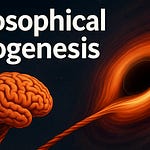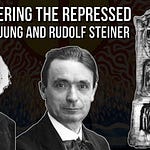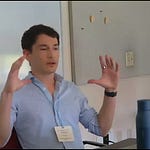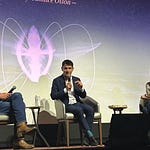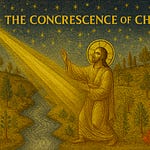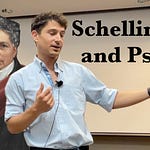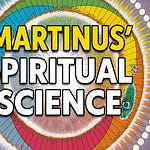Below is a ChatGPT summary of the transcript of my conversation with Richard Smith and Adam Shields. I reviewed and lightly edited it for accuracy. Substack also automatically creates an exact transcript if you’d prefer that. I admit I feel profoundly ambivalent about using AI for these purposes. Part of me worries that by even using these “tools” (which of us is the tool?) for transcription and summary purposes I am contributing to the corporate colonization and extractive commodification of the last remaining inner vestiges of free human cognition. Another part of me finds it tremendously liberating to let the machine produce these sorts of transcripts and summaries, since I certainly don’t have time to do this myself. For now I feel like it is important to stay involved in digital culture and not pretend I might retreat from our current trajectory and remain relevant. So I remain in it but not of it, or at least am holding out for faith not just in better messages but in the redemption of the medium itself. It may be that our civilization is spiraling into cultural and ecological suicide. Or maybe the digital is indeed a new form of life. I’d rather participate in shaping a pro-human and ecozoic future for the technosphere than cede its design to the transhumanists.
Matt Segall begins by reflecting on his schedule of recorded conversations, explaining that he accepts as many invitations as he can manage because discussion and expression are integral to how he learns. Adam Shields thanks him for being so prolific, saying that Matt’s work has served as a “big door” for his own growth over the past year. Matt reflects on how dialogue is inseparable from knowledge in his view: true understanding for him only emerges in an interplay with others. Richard Smith then describes his aspiration for this particular conversation, mentioning that it will center partly on quantum information theory and on themes that stretch back to Wolfgang Smith’s ideas.
Richard recounts his own work with Wolfgang: he ran Wolfgang’s foundation for a couple of years and got him online, recorded numerous hours of private conversations, and convened a discussion group around Wolfgang’s work. Hearing that, Matt praises the archival preservation of Wolfgang’s ideas and observes how valuable that kind of preservation will be for future influence. Richard confirms his intention to keep Wolfgang’s contributions alive in some form, recalling how Matt interviewed Wolfgang in the past and how Whitehead’s philosophy emerged as a point of intersection during that interview.
Richard asks Matt where he sees Whitehead overlapping or diverging from Wolfgang Smith’s perspective. Matt answers that Wolfgang shared Whitehead’s rejection of the “bifurcation of nature,” the idea that the physical world is distinct from the realm of qualities and interiority. Both thinkers refuse to treat mind as a mere byproduct or epiphenomenon. However, a key difference, according to Matt, is that Wolfgang saw time and history more as an appearance—the real is the one eternal wholeness—whereas Whitehead, a pluralist, balances the many and the one. Whitehead preserves genuine novelty in each evolving moment, which for him includes the possibility that even the divine does not fully know what arises next. Matt suspects Wolfgang, as a Catholic, might have supported some sort of historical narrative, but his emphasis on the eternal oneness fundamentally differs from Whitehead’s picture of an evolving cosmos. Adam chimes in with how Wolfgang spoke about “vertical causation” and was struck by Wolfgang’s statement that vertical causation occurs “instantaneously.” Coming from a physics background, Adam finds that jarring, and he wanted Matt to compare Whitehead’s notion of concrescence to Wolfgang’s vertical causation.
Matt explains that Whitehead revitalizes formal and final causation—dimensions largely abandoned by modern mechanistic science—and holds that each moment of experience (each “actual occasion”) unfolds in a process of ingression, prehension, and concrescence. That process includes not only external physical interactions but also the ingress of timeless forms and an ongoing aim or telos. While Wolfgang ties nonlocal phenomena to a single wholeness transcending time, Whitehead describes a cosmos in which every occasion recapitulates the entire universe in its own creative act. Both approaches reintroduce a holistic sense of causality beyond standard “push-from-behind” mechanics, yet Whitehead puts more weight on genuine becoming, whereas Wolfgang underscores a single underlying eternal ground.
Richard turns the conversation to personal history, asking Matt how he came to do what he does. Matt recounts discovering a love for reading and philosophy in high school, shifting his ambitions from professional hockey to voraciously exploring historical and philosophical texts. He studied cognitive science as an undergraduate, then entered the Philosophy, Cosmology, and Consciousness program at the California Institute of Integral Studies (CIIS), a program founded by thinkers like Richard Tarnas and Brian Swimme. Richard, for his part, studied math at Berkeley and became interested in Gurdjieff, Jacob Needleman, and other figures bridging spirituality with rational inquiry. His own path eventually led him to convert to Catholicism, guided in large part by Wolfgang’s thought, which helped reconcile his mind with what his heart already felt to be true.
The conversation shifts to Catholicism’s place in science. Richard observes that Catholic scholastic theology arguably contributed to the idea of a rationally ordered universe, a perspective inherited by modern science, though science eventually set aside the theological underpinnings. He laments the modern notion that we can stand outside the world as pure observers. Meanwhile, Adam raises the topic of quantum information theory, referencing Chris Fields and the notion of “quantum reference frames,” where certain quantum states are expressible in finite bit-strings (speakable or fungible information) while other aspects remain non-fungible (unspeakable) and would require an infinite description. Adam interprets these distinctions in a process-relational way, suggesting that entangled quantum systems define each other without reference to an external observer, and that measurement must inevitably break this open-endedness by halting the infinite possibilities.
Richard takes that as confirmation that there is a gap between what is finitely computable and what is genuinely infinite. To him, vertical causation clarifies what can never be reduced to purely horizontal, mechanistic processes. Adam clarifies his view that “computation” in the quantum world may be a non-halting process, whose completeness remains out of reach for any finite measurement, but that does not make the quantum realm unreal. Matt connects this to Whitehead’s two modes of analysis—coordinate (the measurable, data-oriented side of reality) and genetic (the interior, concrescent process)—and suggests that science’s usual coordinate analysis cannot capture the inward reality that is aesthetic, experiential, and ceaselessly creative.
All three grapple with how religious experience addresses genuine relationality and personhood. Richard explains how Catholicism draws him because it places the human person at the center of value. He sees it as a spiritual community that welcomes everyone, including those with profound disabilities, as equals in a shared liturgy. He voices frustration that modern, technology-driven society treats consciousness as an emergent or computable phenomenon and might even imagine sentient machines, which he finds deeply dehumanizing. Matt concurs that many people will likely seek stronger community ties and spiritual grounding as technology grows more alienating. At the same time, Matt acknowledges a personal struggle to find an institutional religious home; he sees truth in Catholic thought and sacramentality, yet remains open to broader ecumenical possibilities and respects other paths. Richard reminds him that the institutional form itself, even if not perfect, can be valuable as a container that nurtures practice, discipline, and understanding.
They contemplate the historical and cultural shifts brought about by communication technologies, citing Marshall McLuhan (himself a Catholic) and the printing press’s role in the Reformation. Matt compares each epoch-changing medium—alphabet, printing press, radio, television, internet—as reshaping collective consciousness. He and Adam note that postmodernism, metamodernism, and other theoretical frameworks also track these changes, as new media alter the flow of information and human self-understanding. Richard speaks about the continuing draw of the Church, citing the revival of interest in traditional forms like the Latin Mass among younger Catholics, who find meaning and community there. He also sees in Catholicism an unbroken thread of centuries of thought—an immense historical dialogue dealing with the same spiritual realities that puzzle modern seekers.
Adam circles back to the tension between novelty and tradition, referencing metamodernism’s focus on new forms of community and sense-making. He acknowledges the power of technology to introduce genuine novelty, which spurs cultural transformation, but also wonders how small communities can scale or avoid the pitfalls of institutionalization. Matt introduces “chaosmogenesis,” a term inspired by James Joyce and later Deleuze and Guattari, combining the notion of a cosmos with creative chaos, and suggests that Christ can be understood as mediating between order and chaos—not simply enforcing one side or the other, but transforming what he calls “the all-nourishing abyss” into new forms that integrate love and novelty.
They end with reflections on the Incarnation and the Christian narrative that the Creator enters creation, implying a profound shift: God is no longer solely transcendent but also deeply immanent within history and humanity. Matt imagines that in the future, scientific textbooks might one day include the logic of the Incarnation as part of a more participatory, holistic view of reality. He sees religion and science converging in a new sense that the cosmos is ongoingly created and that personhood, rather than being a byproduct, stands at the heart of it all.
As the conversation concludes, the three men express gratitude and the hope that they can reconvene. Matt praises how fruitful it has been to hear everyone’s backgrounds, doubts, and commitments. Richard returns once more to Wolfgang Smith, thanking him for resisting the purely mechanistic worldview, even if Wolfgang’s stubborn style caused friction. The conversation closes on a note of mutual curiosity and respect, with Matt, Adam, and Richard all committed to exploring the mysterious union of mind, matter, personhood, and the divine.





